
views
Soaking the Pinecones
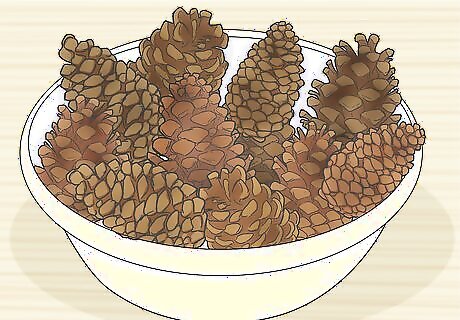
Collect some pinecones. You can use ones that are already opened or those that are closed. Closed pinecones will open up when they dry during the baking process. Store bought pinecones are already clean and ready to use.
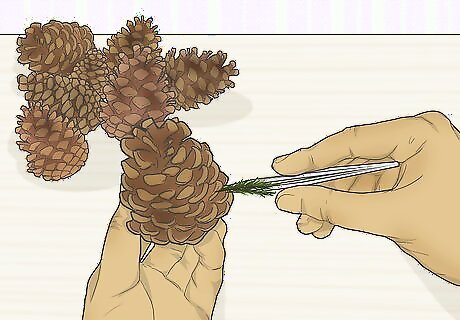
Remove any debris caught inside the pinecones. This includes things like seeds, moss, and pine needles. You can do this with a pair of tweezers or a brush. Don't worry about being too precise, though; soaking the pinecones will help clean them further.

Prepare a solution of water and vinegar. Fill a sink, tub, or bucket with two parts water and one part white vinegar. The amount of water and vinegar you end up using depends on how many pinecones you're going to soak and the size of your container. If you prefer, you can use a solution of 1 gallon (3.8 liters) of water and 1 teaspoon of mild dish soap.

Soak the pinecones for 20 to 30 minutes. You need the pinecones to remain submerged during this step. If they don't stay down, weigh them down with a wet, heavy towel, a pot lid, or even a dinner plate. The pinecones may close up during this step. Don't worry -- they'll open up again when they dry.

Transfer the pinecones to newspaper and let them dry overnight. Be sure to leave them in a well-ventilated area, as this will help increase airflow. If you don't have any newspaper on hand, use paper bags or an old towel instead.
Baking the Pinecones

Preheat your oven to 200 to 250°F (94 to 122°C). You don't need the oven to get very hot. The pinecones just need some gentle heat to help dry them fully, so they'll open again after soaking.
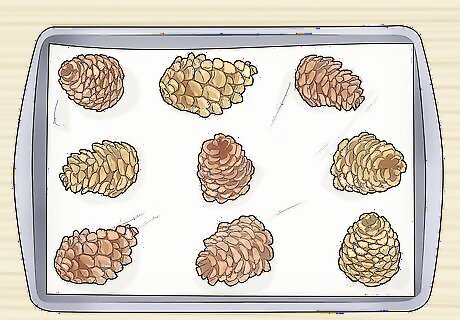
Set the pinecones on a baking sheet lined with parchment paper. If you don't have any parchment paper, you can use aluminum foil instead. Leave some space between each pinecone. This allows the hot air to flow better between them and gives them room to open up.
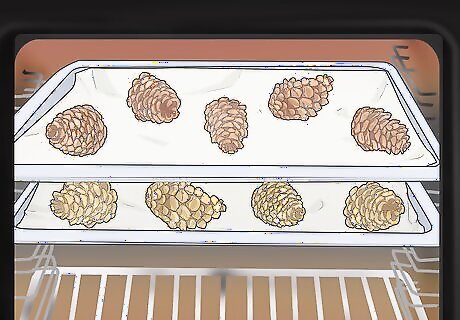
Bake the pinecones until they open up. This may take anywhere from 30 minutes to two hours. Check the pinecones frequently, though, so that they don't catch on fire. They're ready when they're shiny and fully opened. If you prefer, you can leave the pinecones out to air dry so they open up again. However, it can take two to three days for them to open, which makes baking a good idea if you don't have much time.

Transfer the pinecones to a wire cooling rack. Use a pair of oven mitts, tongs, or even a soup ladle to do this. Be careful while moving the pinecones; they'll be very fragile.

Allow the pinecones to cool for at least 10 minutes. Once they're cool, you can paint them, display them, or seal them further. They will have a shiny coating on them, which is just melted sap. This can act as a natural preservative. If you want to preserve them further, you should finish them.
Finishing the Pinecones

Prepare your workspace and decide on a finishing method. Whether you're spraying, painting, or dipping the pinecones in a sealing product, you'll want to cover your counter or table with newspaper. If you're using a spray sealer, it's even better to work outside. Once you have your space set up, go ahead with your chosen sealing method.

Spray the pinecones if you want something quick and easy. Choose a non-yellowing spray varnish. Lay the pinecones on their sides, then spray them using an even coat. Wait for the pinecones to dry for 10 minutes before rotating them and spraying the other side. Let the sealer dry for at least a half hour before applying another coat. Spray sealers come in many different finishes: matte, satin, and glossy. Choose the one that you like the best. The matte usually offers the most natural look, though. If you don't have any spray varnish, you can try using hairspray instead.
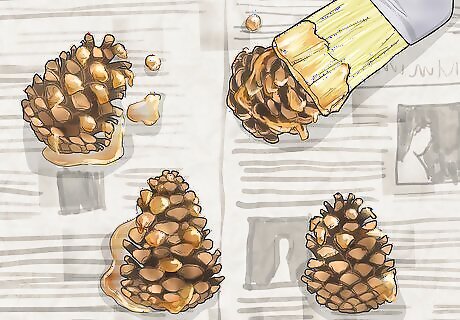
Use a marine varnish if you want something more durable. Purchase a marine varnish from a hardware or home improvement store. Put on a pair of disposable gloves and hold the pinecone by the tip. Use a cheap, disposable brush with stiff bristles to apply the varnish all over the pinecone, except for the bottom. Let the varnish dry for at least 30 minutes, then hold it by its sides, and coat the bottom and tip. Leave the pinecone to dry on its side. You can apply more than one coat of marine varnish, but you have to let the previous coat dry fully. Alternatively, you can tie some thread to the top of the pinecone, then dip it into the varnish. Lift it out, and let the excess varnish drip off. Hang the pinecone by the string to dry.

Dip the pinecones in paint or varnish if you want a thicker coating. Wrap some string or thin wire around the top of a pinecone. Dip the pinecone into a can of paint or varnish. Lift the pinecone out, and hold it above the can for about a minute to let the excess paint/varnish drip back. Use the string or wire to hang the pinecone someplace where it can dry. Place a newspaper or tray under the pinecone to catch any drips of paint or varnish. Keep in mind that this method may cause the pinecones to close up again. If the paint or varnish is too thick, thin it with water. Use 4 parts paint or varnish to 1 part water.

Dip the pinecones in beeswax as an alternative to varnish or paint. Melt enough solid beeswax in a crockpot to fully submerge the pinecone. Tie a string around the tip of the pinecone, and hold it to dip the pinecone into the melted wax. Lift the pinecone out, and immediately dip it into a bucket of cold water. You may have to repeat this step a few times to get an even coverage. Heat the wax in the slow cooker on high for 2 to 3 hours or until it melts completely. If you don't have a slow cooker, you can also melt the beeswax in a double boiler on the stove. Let the wax set on the pinecone for at least 3 minutes before setting it down. The more you dip the pinecone into wax, the more visible the wax will become. You may wind up with a yellow or white pinecone.



















Comments
0 comment